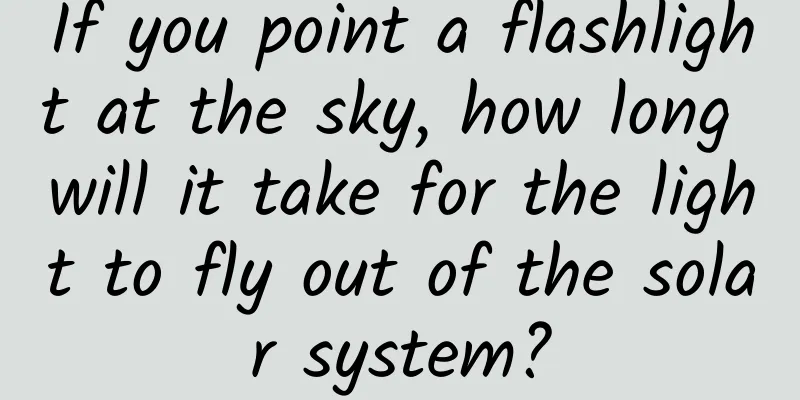If you point a flashlight at the sky, how long will it take for the light to fly out of the solar system?

|
This article is based on answering questions from netizens such as: If we shine a flashlight at the sky, will the light leave the solar system tomorrow? Simply put, no. This is because the speed of light is not that fast and the size of the solar system is not that small. The general understanding of modern science is that there is an Oort cloud outside the solar system, which is composed of large and small ice blocks formed by a mixture of water vapor and dust, also known as comets. It is the edge of the solar system and surrounds the sun to form a sphere with a radius of about 1 light year. Of course, this "ball" is just an imagination. It is said that there are as many as 10 trillion comet seeds there, but they are scattered in the vast space with a thickness of 1 light year. It is still very sparse, more sparse than people can imagine. It is just much denser than the space where even particles are extremely scarce. It is precisely because this layer of Oort Cloud is too sparse for human eyes that it does not affect scientists' observation of the outer solar system, and people can see almost all the stars, galaxies and nebulae outside the solar system; at the same time, the space probes launched by humans can fly out of the solar system without hesitation. For example, Voyager 1, 2, Pioneer 10, 11, and New Horizons, after completing their missions of exploring the solar system planets, are all flying out of the solar system, and scientists almost never consider that they will be destroyed by these small celestial bodies. Because the probability of this happening is so small, it is much smaller than the chance of winning the Mark Six lottery. The so-called light-year is a distance scale, which is the distance that light travels in one year. Specifically, the speed of light in a vacuum is 299,792,458 meters per second (about 300,000 kilometers). A 24-hour day is 86,400 seconds. According to the Julian year for calculating light years, each year is 365.25 days, or 31,557,600 seconds. The distance that light travels in one year is about 9.46 trillion kilometers. Since the solar system has a radius of one light year, if we shine a flashlight into space, the light will certainly not be able to fly out of the solar system tomorrow. Instead, it will take a whole year to fly to the edge of the solar system's Oort Cloud and then fly out of the solar system. But the problem is that light will attenuate. When photons encounter various charged particles, they will interact, that is, they will be reflected, refracted and absorbed by various charged particles. Once the flashlight light is emitted, it moves at a speed of about 300,000 kilometers per second. It will collide, reflect and absorb with particles many times in a very short time. Therefore, this weak flashlight light disappears in less than a second. Even in the outer space outside the earth, which appears to be a highly vacuum state, there is no absolute vacuum in the universe, let alone in the solar system, so the faint light of a flashlight will quickly disappear in space. The more photons a light source emits, the greater the energy of the photons, and the farther they can travel. This is why the light of larger stars can travel farther, even hundreds of millions of light years, and can be seen by telescopes. The greater the energy emitted by a galaxy, the farther its light can travel; gamma-ray bursts are the highest energy light, so they can travel up to billions of light years. Conclusion: The light from the flashlight will disappear in less than a second and will never leave the solar system. |
Recommend
Which is healthier, going to bed early and getting up early or going to bed late and getting up late?
A friend complained to Huazi about her poor sleep...
How did the killer bees, which scare people to death, sweep across America? It all started with a species improvement
Brazil is the seventh largest honey producer in t...
25 “Empty-Empty” APP Promotion Methods, You Deserve It!
Due to various reasons, our company is not like m...
How do new media operators choose popular content?
Everyone who works in new media must have thought...
6 conversion rate analysis models to improve product conversion!
1. Why is conversion rate becoming more and more ...
The 10 most popular growth hacking strategies in 2018!
We feel it’s necessary to share with you our rese...
How to keep up with demand for primary product operations?
The product operation here refers to chivalrous p...
In a red ocean market with no resource advantages, how did NetEase Cloud Music achieve 300 million users?
In a situation where music player apps are in a c...
Is it reliable to increase traffic by using short videos? What should you pay attention to when increasing the number of views on short videos?
This article mainly introduces whether it is reli...
5 ways to divert traffic from TikTok to WeChat!
With the explosive popularity of TikTok, more and...
How does Baidu charge for paid ranking?
Baidu bidding is paid per click. If this happens,...
Toyota Motor Financial Report: Net profit in Q2 of fiscal year 2024 fell 55% year-on-year
Toyota Motor released its financial report for th...
Private domain operations will start in 2022!
This article is a recent review of more than a do...
A popular blogger ate vegetarian food for 5 years and developed severe anemia. Why did this happen? Uncover the truth about vegetarianism
Is it healthier to be a vegetarian? In the eyes o...
Look at the roses blooming on the roadsides in Beijing. Do they look like the roses you received?
As a synonym for love, roses have witnessed many ...









